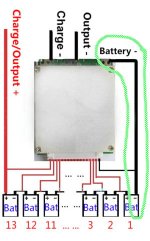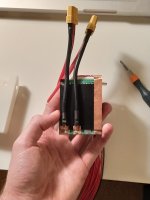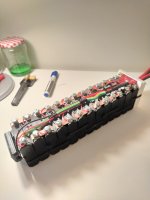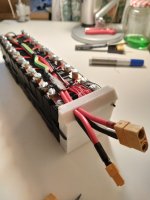KevMca
1 mW
- Joined
- Feb 8, 2020
- Messages
- 10
I have a newly built 13s li-ion battery using the NESE battery modules. I have a cheap 13s BMS from banggood (https://m.banggood.com/13S-35A-48V-Li-ion-Battery-Protection-Board-BMS-PCB-with-Balance-For-E-bike-Scooter-p-1286039.html?rmmds=search#popupStatedetail). It's model is cf-60v20a-a.
The problem is that when I plug it in to charge it won't charge using my 13s charger and it also won't supply power to my ebike. Every group of cells is exactly 3.611V. I have used the charger before on an old battery pack. I have two connectors. The charge connector is connected to C- and the + of the battery and the power connector is connected to P- and the + of the battery.
What's weird is that the voltage across the charge connector is 44.5V and the voltage across the power connector is 43V. The battery pack is 47V so I would have presumed that it would be 47V on those connectors. Is this BMS dead, or am I connecting it incorrectly or something else entirely?
The problem is that when I plug it in to charge it won't charge using my 13s charger and it also won't supply power to my ebike. Every group of cells is exactly 3.611V. I have used the charger before on an old battery pack. I have two connectors. The charge connector is connected to C- and the + of the battery and the power connector is connected to P- and the + of the battery.
What's weird is that the voltage across the charge connector is 44.5V and the voltage across the power connector is 43V. The battery pack is 47V so I would have presumed that it would be 47V on those connectors. Is this BMS dead, or am I connecting it incorrectly or something else entirely?





